Watercubs & Kivisilmän
working show-quality newfoundlands
and history
written by Bettina Salmelin
A
study of the difference of the importance of early stimulation in different
breeds of dogs
Technical Summary
As the number of purebred dogs (Canis familiaris) is increasing all over the world and the importance and status of dogs is increasing, the importance of breeding mentally stable dogs is becoming more important (FCI, 2008). The amount of canines used as an aid for disabled has increased enormously in the few past decades (The Seeing Eye, 2008).
The majority of the behavior of the dog is reflected from its experiences from its first seven weeks of life (Scott & Marston, 1950). Early stimulation and the possibility of triggering and activating specific signals at early stages of the lifecycle stimulates the brain before it would normally be stimulated. The advantage of this is that the puppies will become more resistant to stressful situations, more stable emotionally and with a higher learning capacity (Fox 1978).
The problems of early stimulation are that the limit of stimulation that produces favourable results is still unclear. If the brain is over stimulated at a very early stage, the brain does not learn to relax and the puppy will constantly feel stressed and unsafe (Scott & Marston, 1950).
Lay summary
Purebred dogs (Canis familiaris) are becoming increasingly popular in the world. There are over 400 different breeds recognized by the Federation Cynologique Internationale (FCI, 2008). People have realized that dogs are of great economical benefit to humans; they can detect mines, smell drugs, find lost people and will be always be loyal to the owner.
With the dog population increasing rapidly, the importance of mentally stable dogs is of greater importance than before. The use of dogs as aids for disabled people is also increasing, and the mental and emotional stability of these guide and help dogs is of grave importance (The Seeing Eye, 2008).
The majority of the behavior of the dog is reflected from its experiences from its first seven weeks of life (Scott & Marston, 1950). It is important the breeders know the best way they can help to breed mentally stable dogs.
Background
The development of the canine (Canis familiaris) behavioural patterns can be divided into four distinct learning phases; the prenatal-, neonatal-, transition-, and the socialization- & juvenile phases. Arguably the most important phase is the socialization phase, but the others are also very important.
The prenatal period is usually much overlooked, since it is very hard to determine the effects of external stimuli that appear long after the stimulation. However, there have been studies in rodents which conclude that if the parent has been stressed during pregnancy, the puppies will become more reactive to emotions and external stimuli (Thompson 1957; Thompson, Watson & Charlesworth, 1962).
The neonatal phase occurs during the first two weeks of life and the puppy is still unresponsive to environmental stimuli, blind and deaf. Even though the puppy is still unresponsive, stress during this time adapts its the pituitary-adrenocortical system to react better later on in stressful situation (Levine 1967). The benefits of this adaption are improved stress resistance, emotional stability and increased learning capacity (Fox 1978).
Battaglia (2001) showed similar results after handling puppies each day 25 seconds between 3-16 days after birth. The results showed that the littermates that had been stimulated for this period of time had improved cardio vascular performance (heart rate), stronger heart beats, stronger adrenal glands, were more tolerance to stress and had greater resistance to disease. They were also more active and dominant over those which were not stimulated. In nature, this would lead that the stimulated puppies would be evolutionally more beneficial in surviving.
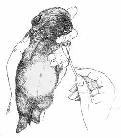
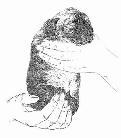
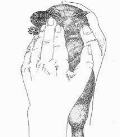
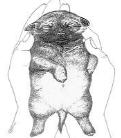
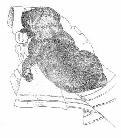
Figure 5: Tactical
stimulation (between toes), head held erect, head pointed down, supine
position and thermal stimulation (Battaglia, 2001).
C. Sighieri et al. (2006) conducted the same experiments as Battaglia (2001) had done, handling the puppies between 3 to 19 days after birth. The results they gathered at the age of 2 months by seeing how they respond in stressful situations and how active they were. The results showed that the most significant differences that arose were from the Isolation test, where the stimulated group, in average, yelped later and spent more time exploring the new room. There was no significant difference in the Arena test, where the puppies were left in a room with a person to see how actively the puppies played with the new objects.
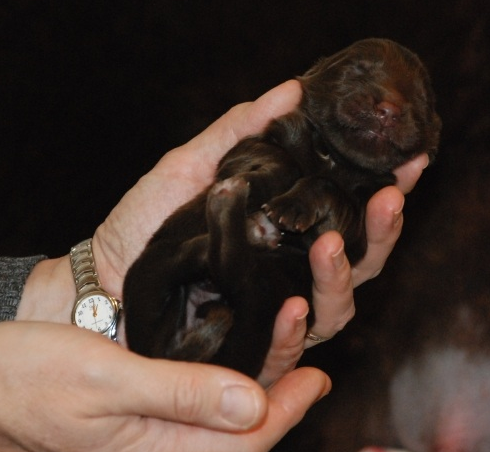
Figure 1:
A puppy can feel safe and sound in human hands if properly introduced.
Newfoundland puppy in supine position (Salmelin, 2008).
Transition period occurs during 13-20 days after birth, when the puppies change to act more like adults. They start to see and hear and move around. As for learning and effects of the early stimulation, this phase resembles the neonatal period. They do not have the capacity to remember and learn very fast at this stage yet. They show only slight increases in ability of performance and rate of learning, but it has been shown that this phase is not yet the most important one, when considering the effect to the later stages of life (Scott & Fuller, 1965).
The fourth phase contains the socialization and the juvenile
periods. They are very closely related and overlap to some extent, so they
are usually clumped together. During primary socialization the puppies form
direct relationships with their littermates, pack members and parents. They
also for tight connections to the environment they are reared in (Scott &
Fuller, 1965).

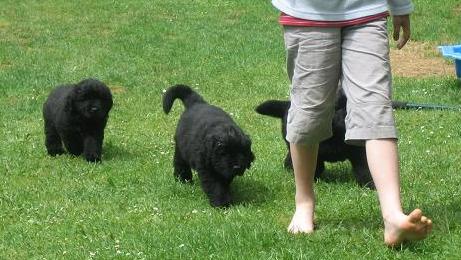
Figure 2 & 3: Stimulated puppies form tight relationships with the
littermates, parents and humans (Salmelin, 2005).
Freedman et al. (1961) was the first to conclude from their
experiments that the largest part of socialization of dogs occurs between
2-13 weeks. The results from their experiment, handling different groups of
puppies intensely for a week between 0-14 weeks, showed that the puppies
handled between 5 weeks and 9 weeks were most socialized.
Scott & Fuller (1965) specified that by the age of 8 weeks, the puppies
should have been socialized to everyone they will meet and form a bond in
their lives, by 12 weeks they should have met everything they will encounter
in later on. The introduction to new things after that window will result in
inadequate socialization, due to the fearfulness and insecurity of the
puppy. If the window has been missed, it is still possible to socialize them
between 6-7 months, but it will take longer (Woolpy & Ginsberg 1967; Nieburh
et al., 1980).
However, in a recent study the period during which the puppies should leave has been criticized. The littermates taken out at 6 weeks had a higher mortality rate, were more stressed and more susceptible to disease than the littermates kept until 12 weeks. They did, however, show the same level of socialization. (Slabbert & Rasa, 1993).
As many studies above have concluded; the childhood of a puppy is the most important factor in the formation of the character and degree of socialization in dogs (Scott & Marston, 1950). If the window is missed, it is very hard to obtain good results (Scott & Fuller, 1965). Therefore it would be wise to conduct a study which determines more accurately what should be done, what effect it has, and which exercises are more important in other breeds compared to others.

Figure 4: A calm Newfoundland puppy under stimulation (Salmelin, 2005).
The “childhood” of a dog (Canis familiaris) is the most important factor in the formation of the character and degree of socialization in dogs (Scott & Marston, 1950). If the window is missed, it is very hard to obtain good results (Scott & Fuller, 1965).
There
is evidence that the transition period in wolves starts slightly earlier,
and their development is faster compared to that of dogs (Frank & Frank
1982, 1985; Zimen, 1987). Can
this difference be seen within the same species?
Reference list
Battaglia, C. L. (2001) Developing Higher Achievers. [online] http://www.breedingbetterdogs.com/early.pdf [Accessed 12th March 2008].
FCI, (2008) Federation Cynologique Internationale. [online] http://www.fci.be [Accessed 12th March 2008].
Fox, M. W. (1978). The Dog: Its Domestication and Behavior. New York: Garland STMP Press.
Frank, H. & Frank, M. G. (1982). On the effects of domestication on canine social development and behavior. Applied Animal Ethology, 8, 507-25.
Frank, H. & Frank, M. G. (1985). Comparative manipulation-test performance it ten-week-old wolves (Canis lupus) and Alaskan malamutes (Canis familiaris): a Piagetian interpretation. Journal of Comparative Psychology, 99, 266-74.
Freedman, D. J., King, J. A., Elliot, O. (1961). Critical periods in the social development of dogs. Science, 133, 1016-17.
Levine, S. (1967). Maternal and environmental influences on the adrenocortical response to stress in weanling rats. Science, 156, 258-60.
Nieburh, B. R., Levinson, M., Nobbe, D. E. & Tiller, J. E. (1980). Treatment of an incompletely socialized dog. In Canine Behavior, ed. B. L. Hart, p. 83. Santa Barbara, CA: Veterinary Practice Publishing Co.
Salmelin, B. R. M., (2005) Larinkallion H-litter of Newfoundlands.
Scott, J. P. & Fuller, J. L. (1965). Genetics and the social behavior of the dog. Chicago: University of Chicago Press.
Scott, J.P., Marston, M. V. (1950). Critical periods affecting the development of normal and mal-adjustive social behavior of puppies. Journal of Genetic Psychology, 77, 25-60.
Slabbert, J. M. & Rasa, O. A. E. (1993). The effect of early separation from the mother on pups in bonding to humans and pup health. Journal of the South African Veterinary Association, 64, 4-8.
Sighieri, C., Mariti, C., Martelli, F., Baragli, P., Ducci, M. & Gazzano, A. (2006). Effects of postnatal handling on the ontogenesis of canine behaviour. Veterinary Research Communications. 30 (Suppl. 1), 211-13.
The Seeing Eye, (2008) [online] http://www.seeingeye.org/ [Accessed 12/03/08]
Thompson, W. R. (1957). Influence of prenatal and maternal anxiety on emotionality in young rats. Science, 125, 698-9.
Thompson, W. R., Watson, J. & Charlesworth, W. R. (1962). The effects of prenatal maternal stress on offspring behavior in rats. Psychological Monographs, 76, 1-26.
Woolpy, J. H. & Ginsberg, B. E. (1967). Wolf socialization; A study of temperament in a wild social species. Amercan Zoologist, 7, 357-63.
Zimen, E. (1987). Ontogeny of approach and flight behavior towards humans in wolves, poodles and wolf-poodle hybrids. In Man and Wolf, ed. H. Frank, pp. 275-92. Dordrecht, The Netherlands: Dr W. Junk Publishers.
(c) Salmelin